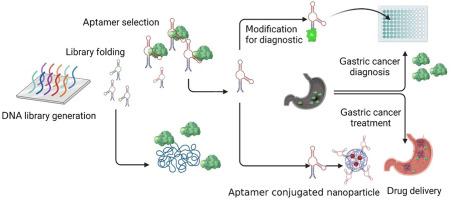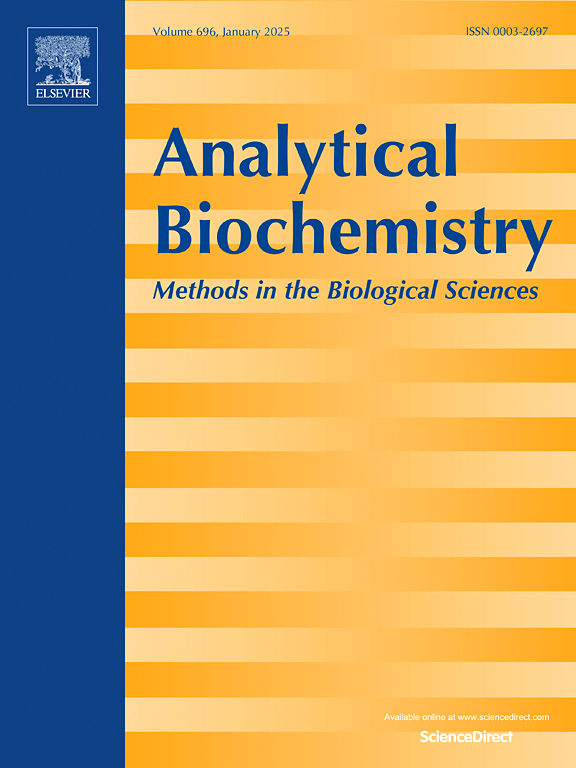适体技术及其在胃癌中的最新应用进展
IF 2.5
4区 生物学
Q2 BIOCHEMICAL RESEARCH METHODS
引用次数: 0
摘要
胃癌(GC)是全球癌症相关死亡的主要原因之一,诊断较晚,治疗效果有限。胃癌化疗和放疗面临的主要挑战包括耐药、全身毒性、有限的肿瘤选择性、不良副作用、肿瘤异质性和放射耐药的发展,这些都阻碍了治疗效果和患者预后。适配体是一种单链DNA或RNA分子,对分子靶点具有高特异性和亲和力,为传统的诊断和治疗方法提供了一种有希望的替代方法。由于其高特异性和低免疫原性,适体改善了非侵入性诊断技术,使早期GC检测和靶向治疗应用成为可能。在治疗上,适体促进精确的药物靶向,减少全身毒性和改善治疗结果,特别是对耐药和转移病例。与纳米技术的结合进一步增强了它们的潜力,使诊断和治疗相结合的治疗应用成为可能。尽管取得了这些进展,但生理稳定性、肾脏清除率和组织渗透性等方面的挑战仍然存在,因此需要进一步研究化学修饰和基于纳米载体的递送系统。本研究全面回顾了适体技术的最新进展及其在GC中的应用,特别强调了诊断和治疗策略。第一部分探讨适体发展策略,包括新兴的选择技术和分子修饰,以提高其特异性和稳定性。下一节探讨适体在胃癌诊断和治疗中的作用,重点是靶向化疗和免疫治疗。最后,我们讨论了目前基于适配体的方法所面临的挑战,并概述了其临床翻译的未来前景。本文章由计算机程序翻译,如有差异,请以英文原文为准。

Advances in aptamer technology and its updated applications in gastric cancer
Gastric cancer (GC) is one of the leading causes of cancer-related mortality worldwide, with late-stage diagnosis and limited treatment efficacy. The major challenges in chemotherapy and radiotherapy for GC include drug resistance, systemic toxicity, limited tumor selectivity, adverse side effects, tumor heterogeneity, and the development of radioresistance, all of which hinder treatment efficacy and patient outcomes. Aptamers, single-stranded DNA or RNA molecules with high specificity and affinity for molecular targets, offer a promising alternative to traditional diagnostic and therapeutic approaches. Due to their high specificity and low immunogenicity, aptamers improve non-invasive diagnostic techniques, enabling early GC detection and targeted therapeutic applications. Therapeutically, aptamers facilitate precise drug targeting, reducing systemic toxicity and improving treatment outcomes, especially for drug-resistant and metastatic cases. Integration with nanotechnology further enhances their potential, enabling theranostic applications that combine diagnosis and therapy. Despite these advancements, challenges such as physiological stability, renal clearance, and tissue permeability remain, necessitating further research into chemical modifications and nanocarrier-based delivery systems. This study provides a comprehensive review of recent advancements in aptamer technology and its evolving applications in GC, with a particular emphasis on diagnostic and therapeutic strategies. The first section explores aptamer development strategies, including emerging selection techniques and molecular modifications to enhance their specificity and stability. The subsequent section examines the role of aptamers in GC diagnostics and treatment, with a focus on targeted chemotherapy and immunotherapy. Lastly, we discuss the current challenges in aptamer-based approaches and outline future perspectives for their clinical translation.
求助全文
通过发布文献求助,成功后即可免费获取论文全文。
去求助
来源期刊

Analytical biochemistry
生物-分析化学
CiteScore
5.70
自引率
0.00%
发文量
283
审稿时长
44 days
期刊介绍:
The journal''s title Analytical Biochemistry: Methods in the Biological Sciences declares its broad scope: methods for the basic biological sciences that include biochemistry, molecular genetics, cell biology, proteomics, immunology, bioinformatics and wherever the frontiers of research take the field.
The emphasis is on methods from the strictly analytical to the more preparative that would include novel approaches to protein purification as well as improvements in cell and organ culture. The actual techniques are equally inclusive ranging from aptamers to zymology.
The journal has been particularly active in:
-Analytical techniques for biological molecules-
Aptamer selection and utilization-
Biosensors-
Chromatography-
Cloning, sequencing and mutagenesis-
Electrochemical methods-
Electrophoresis-
Enzyme characterization methods-
Immunological approaches-
Mass spectrometry of proteins and nucleic acids-
Metabolomics-
Nano level techniques-
Optical spectroscopy in all its forms.
The journal is reluctant to include most drug and strictly clinical studies as there are more suitable publication platforms for these types of papers.
 求助内容:
求助内容: 应助结果提醒方式:
应助结果提醒方式:


